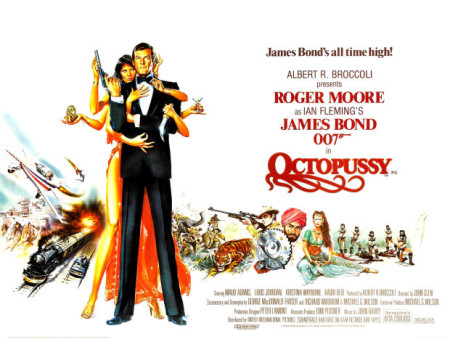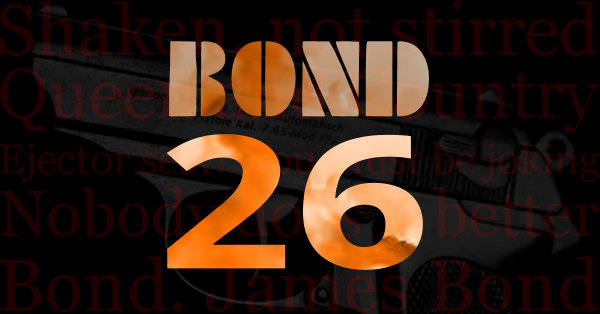Octopussy may seem a long way from Ian Fleming’s books. But it turns out there are elements of Fleming in Roger Moore’s 1983 film.

Author’s note: Although penned for the 30th anniversary of Octopussy in 2013, this article remained unpublished until now. The rather prescient comparison between General Orlov and Vladimir Putin dates from then.
If you think of the Roger Moore era several things may come to mind. Bond’s single arched eyebrow, perhaps; or an emphasis on humour in favour of dramatic tension; over the top gadgets, like Moonraker’s gondola turned hovercraft; or those safari suits. Whatever it is that comes to mind, it’s unlikely to be much of an association with Ian Fleming’s books.
While the early films up to Thunderball, and then On Her Majesty’s Secret Service, were pretty faithful adaptations of Fleming’s stories, by the time Roger Moore took over the role, Cubby Broccoli and Harry Saltzman had jettisoned Fleming’s storylines. Instead they used little more than the title and character names.
And so it is with Roger Moore’s sixth 007 movie, which seems to owe very little to Ian Fleming beyond appropriating the title of one of Fleming’s short stories. But a closer look at Octopussy reveals that first impression to be misleading. The film turns out to use a number of Fleming elements, as well as being influenced by previous films.
For starters let’s go back to the book. Fleming’s story is not really about James Bond at all, instead telling the WW2 story of a former intelligence officer. Overtaken by greed, he kills his mountain guide in order to hide a horde of Nazi gold, and throws him into a glacier. Only when the guide’s body shows up years later from the melting snow does Major Dexter Smythe’s crime come to light. Bond plays a peripheral role in the story, paying a visiting to Smythe at his Jamaican home to confront him, before taking him back to Britain to face the consequences.
After going over the evidence with Smythe, Bond tells him he will return the next day. But Smythe, a thinly disguised self-portrait of Fleming as an aging alcoholic in poor health, is dragged below the water by an octopus – the eponymous Octopussy – after being accidentally stung by the scorpion fish he is trying to feed it.
The other stories contained in the book are The Property of a Lady (written for Sotheby’s annual journal and absent from the first edition) and The Living Daylights, whilst 007 in New York has been added to more recent editions.
Like Octopussy, The Property of a Lady is an atypical James Bond story, although 007 is directly involved. The plot is simple; a Russian agent is being paid off through the sale at auction of a Faberge egg and Bond goes along to try and identify who is bidding on the egg so that he can be expelled from Britain.
But although elements of the short story were used in the film, very little of Octopussy itself makes it into the script. When 007 finally meets the eponymous Octopussy, her father’s background is clearly taken from Fleming’s story. She thanks Bond for allowing her father the time to commit suicide and take an honourable way out.
But while in Fleming’s story the guide was a father figure to Bond, this personal connection is lost in the film. Contrast this with the tendency in the more recent films for 007 to act outside the remit of MI6 when things do get personal.
What may be more surprising are the elements and influences from Moonraker and Goldfinger that crept into the script. For instance, James Bond’s meeting with Kamal Kahn at the Monsoon Palace, where he beats Kahn at backgammon after realising he is a cheat, comes straight from the pages of Moonraker. In the book it is Sir Hugo Drax he is facing, the venue is Blades, which rather than being a fencing club (as in Die Another Day) is M’s private club, and the game is bridge. This is underlined when Bond, after using Kahn’s own trick to beat him, is warned to spend the money quickly; Drax makes exactly the same warning in Moonraker.
However, even this scene interweaves elements of the movie Goldfinger too. When Kahn asks him to prove he can back his stake, Bond reveals he is in possession of the Faberge Egg; while on the golf course in the screen version of Goldfinger, Bond drops a gold bar on the green after the villain, also a cheat, enquires into Bond’s motives for meeting him. They then play for the gold, with Bond winning the round of golf but only after resorting to cheating himself; and after Kahn loses the bridge game, his henchman crushes the dice with which Bond had just beaten his boss. They were loaded of course, but the scene is reminiscent of Oddjob crushing the golf ball.
And then there is Octopussy and her circus act; it is nothing more than a revisit of Pussy Galore’s Flying Circus. While perhaps in the film version of Goldfinger it isn’t clear, Ian Fleming wrote Pussy Galore as the head of one of the gangs involved in the Fort Knox heist, rather than being simply Goldfinger’s personal pilot. However, in the Roger Moore film it is clear that the circus troupe is a cover for Octopussy’s jewellery smuggling gang.
And while 007 dressed as a clown may appear at first glance to almost perfectly sum up this era of Bond films, the scene was almost certainly inspired by Ian Fleming. In Fleming’s notebooks he described a scene in which a crowd at a masquerade ball thinks a fight with a Russian killer, disguised as a clown, is part of the act.
Although it is possibly coincidental, or at least unconscious, there is another element of Moonraker similar to Octopussy. In the novel, Drax’s objective is to fire his rocket at London to avenge the defeat of Germany in the Second World War. At the same time he would play the stock market to profit from the resulting crash; in Octopussy, General Orlov (Steven Berkoff, playing a character eerily reminiscent of Vladimir Putin) wants to detonate an atomic bomb at a circus on an American airbase in West Germany. This would avenge the dominance of the West over Russia, while looking like an American device had exploded. Public pressure would result in unilateral disarmament and the USSR would be able to invade the rest of Europe, unopposed by any nuclear capability.
The actual bomb countdown appears to be once again influenced by the film version of Goldfinger (in the novel the plan was to steal the gold from Fort Knox rather than irradiate it), although this time the countdown stops with just one second to detonation. And the scene in which Kahn’s henchmen use a yo-yoing circular saw to attack Bond and Octopussy in bed is reminiscent of You Only Live Twice. The result is very different from when Aki is killed by poison dripped into her mouth from above, but the scene feels so familiar.
While many of the films appear, on first viewing, to have little to do with the books, it is often surprising how much Ian Fleming material there is when examined a little more closely. While Octopussy obviously took the storyline of The Property of a Lady and adapted it to fit it into the overall plot, there are several other influences that come straight from the pages of Ian Fleming, as well as from earlier films. While all the novels have now been filmed, with only handful of short story titles unused, it is almost certain that unused elements of Ian Fleming will continue to work themselves into the screenplays.










